Water We Up To?

After a 10-year break, the Hoofer Scuba Club is back in action planning annual remote winter break trips. With an excited group of young divers and the generous aid from a Hoofer Council Grant and the Wisconsin Union Director’s Fund, the Club successfully planned two remote winter break trips in the past year. In staying true to its mission, the Club hopes to expand into international waters and incorporate more citizen science diving in the future. Hoofer Scuba’s mission emphasizes fostering interest, participation, and encouragement in Scuba diving activities by providing leadership, instruction, education, and programs related to environmental concerns and community affairs.


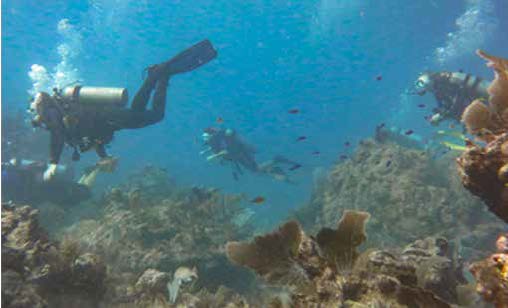
In January 2019, the Scuba Club ventured to the southeastern coast of Florida. In recent decades, about 90 percent of all coral cover in southern Florida vanished due to warming, disease and pollution. These coral reefs play an essential role in the underwater world, from acting as a barrier from storms and surge, to creating enhanced water quality, providing food, habitat, and protection for marine life. With such a large decline in coral abundance and diversity, the club deemed it essential to join restoration efforts and help in any way they could.
After a nearly 23-hour-long car ride, the group of 12 made it to the Miami area. The first two days of diving occurred in Key Largo, where a boat took the enthusiastic divers to the reefs. With a giant stride into the ocean, the group came across nurse sharks, lobsters hiding in nooks and crannies of the reef, schools of snappers, large barracuda circling, and more fish species than one could imagine.
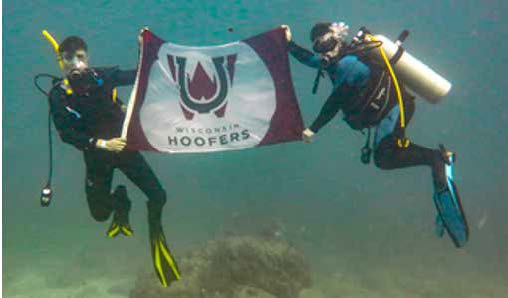
The third full day of the trip was spent at Bill Baggs Cape Florida State Park, a 505-acre park on a barrier island just past the town of Key Biscayne. Since it acts as a refueling station for migratory birds, removing garbage and maintaining a clean environment is of great importance. With the guidance of biologist Dr. Elizabeth Golden, Scuba Club members filled an entire pick-up truck bed with garbage collected throughout the park.
The fourth and final day of diving, Scuba Club members partnered with the University of Miami’s Rescue a Reef citizen science program. To create new reefs where once healthy reefs used to thrive, Dr. Diego Lirman, associate professor at the University of Miami, and his lab team members combat the drastic decline of coral reefs through coral propagation and outplanting.
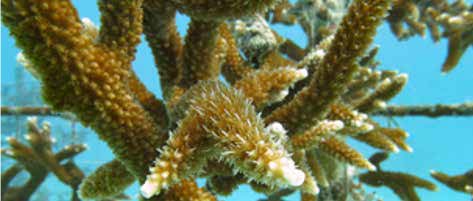
Just offshore of downtown Miami, located in the Key Biscayne National Park, the lab has created nurseries where coral trees, or PVC structures, suspend staghorn coral fragments in the water column. By suspending the fragments in the water column, the coral can grow quickly and decrease the prevalence of disease and predation.
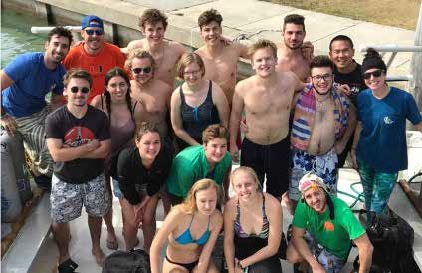
Gearing up for the nearly 23-hour-long car ride home, the divers pondered what they could do to aid in the coral restoration efforts back home. The group decided it would be best to focus on spreading awareness of global climate change and pollution upon its return to Wisconsin.
During the first dive of the day, the group performed regular maintenance at the coral trees. Using wire brushes, the divers scrubbed off any fouling organisms, such as algae, sponges, mussels and barnacles. Once the divers finished cleaning the trees, they clipped off larger branched fragments and prepared for outplanting at a new reef. With a hammer, steel nails, zip ties and fragments of coral in hand, the crew jumped in the water at the new site. The crew made their way to the bottom, about 30 feet down, where they hammered the steel nails into the rocky surface, attaching a coral fragment with a zip tie to each one. The group outplanted nearly 400 new
fragments of staghorn coral, in hopes that the coral would grow and create a new, thriving reef in the years to come.


This January, 10 Hoofer Scuba members dove their way up the central coast of California. Over the past several years, the kelp forests of California have diminished due to warming ocean waters and hungry sea urchins. Meanwhile, the sea urchin population exploded due to a disease rapidly wiping out the region’s sea star population. Some scientists say that the only thing keeping some populations of kelp alive are the sea otters, who like to munch on sea urchins. The concern of the diminishing kelp forests provided an opportunity for learning and engagement for the Scuba Club.
This January, 10 Hoofer Scuba members dove their way up the central coast of California. Over the past several years, the kelp forests of California have diminished due to warming ocean waters and hungry sea urchins. Meanwhile, the sea urchin population exploded due to a disease rapidly wiping out the region’s sea star population. Some scientists say that the only thing keeping some populations of kelp alive are the sea otters, who like to munch on sea urchins. The concern of the diminishing kelp forests provided an opportunity for learning and engagement for the Scuba Club.
Narrowly skipping town during the first major snowstorm of the season, the crew peeled off their jackets and stepped out of LAX into a relatively balmy 60 degrees. The group spent the first two days of the trip with a dive company based in Ventura Harbor. On the hour-long boat ride to and from the dive sites, Bottlenose dolphins graciously decided to join the Club on its adventure and played in the boat’s wake.
Zipping up their thick wetsuits and donning all their gear, the divers slipped into the breathtaking waters of the Channel Islands National Park, just offshore of Anacapa Island. They floated through the swaying kelp, while Juvenile Harbor Seals tugged playfully on divers’ fins and blaze orange Garibaldi, Olive Rockfish, and Anchovy stayed just out of reach. Neon nudibranchs, moon snails, warty sea cucumbers and urchins decorated the kelp stalks. Wonderful alien Christmas trees and enormous, slimy Sea Hares slid past Spiny Lobsters and Leopard Sharks tucked into nooks on the ocean floor. Rafts of young sea lions swirled all around the divers in sandy flats.

Following the first two days of diving, the group adventured up the coast from Calabasas to Monterey via the ever-so-curvy Highway 1, the Pacific Coast Highway. With cliffs on the right and the endless view of the ocean on the left, the five-hour drive seemed manageable. A quick stop at an Elephant seal rookery had everyone in awe, with new pups a mere couple hours old.

Members spent their final day of diving at San Carlos Beach in Monterey. The divers watched the waves crash along the beach as they prepared their gear and slipped into their wetsuits. With sea otters and sea lions playing in the water just a couple hundred yards away, the divers walked into the water and disappeared into the bay. Underwater, they would find neon orange nudibranch, decorator crabs, sea stars, sea cucumbers, bright white anemones, and swell shark eggs, all clinging to a rock wall. Riding the current back into shore, the group passed over a bed of hundreds of living sand dollars, partially dug into the ocean floor.
Scuba Club enjoyed its last day in California entirely at the Monterey Bay Aquarium. Arriving as the doors opened, a diver operations team greeted the group. Two dive team members generously gave the group a behind the scenes tour of the aquarium, explaining all of the intricacies of running a dive program in an aquarium that houses more than 200 exhibits and showcases more than 35,000 animals and plants. The aquarium inspires a broad range of audiences, from young school age groups to families to dive clubs, to take action on some of the ocean’s largest threats. With the support of visitors and educators, the aquarium “strives to influence leaders, conserve wildlife and ecosystems, improve global fisheries and aquaculture, reduce plastic pollution and address climate change.”

The tour group first visited the roof deck, the top of the 335,000-gallon live Kelp Forest exhibit. As a volunteer diver entered the water, the group learned about high-tech equipment divers use at the aquarium. The tour continued with views behind the jelly tanks, above the Monterey Bay Habitats exhibit, through the nursery room, and above the Open Sea tank. Last on the tour, members experienced the visitor’s side of the Monterey Bay Habitats exhibit, where the volunteer divers performed a training feed with the three 200-pound Giant sea bass, California’s largest nearshore bony fish.
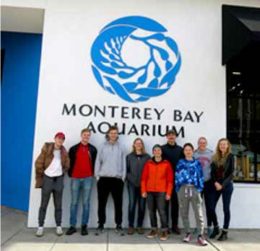
Absolutely amazed with what the aquarium offers, the group chose to stay until close, taking in all the extraordinary organisms on display. The group learned about the aquarium’s many accomplishments, including being the first and only aquarium to build a living kelp forest exhibit, the first to reintroduce southern sea otter pups to the wild using a surrogacy program and the first to successfully exhibit and release great white sharks.
While boarding their plane in San Francisco, Club members reflected on all that they experienced, from observing first-hand kelp forest ecosystems to learning about dive career opportunities in an aquarium setting to gain leadership experience.


Thank you to everyone who joined the Scuba Club or supported its work to reach new depths of learning and giving back. In the past year, the Club explored the seemingly endless depths of our world’s beautiful oceans; delicate, fascinating ecosystems; and hope. In each place that its members found a challenge, the Club also found people ready and willing to help overcome and opportunities to contribute to their work. The group also found comradery with one another and bonded over a shared passion for Scuba diving. In the summer and academic year to come, its members will continue to seek out ways to hone skills, apply learning and make a difference.
The Hoofer Scuba Club offers year-round trips, training sessions and socials, and anyone 18 and over can join. If you would like to learn about joining the Hoofer Scuba Club or how to support the Club, please visit www.hooferscuba.org.
**photos from Daniel Haryanto and Aly Andersen
https://e360.yale.edu/features/as-oceans-warm-the-worlds-giant-kelp-forests-begin-to-disappear
https://www.reefrelief.org/the-importance-of-coral-reefs/
http://reefresilience.org/restoration/coral-populations/coral-gardening/field-based-nurseries/
https://www.sciencemag.org/news/2019/04/scientists-track-florida-s-vanishing-barrier-reef
https://www.montereybayaquarium.org/
